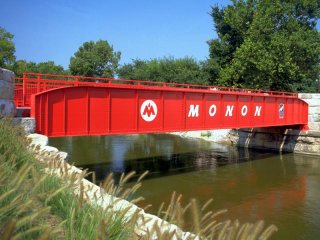John Arnold Leslie (A. L.) Lazarus was born
in 1914 in Revere, Massachusetts, to Benjamin, a merchant,
and his wife Bessie. After attending the College of William
and Mary and the University of Michigan, then holding a teaching
position briefly at the University of California, Lazarus
took a position as a professor of English at Purdue University
in West Lafayette, Indiana,
in 1962.
He
became a distinguished professor and authored more than twenty
English textbooks during his time at Purdue. His poetry was
published in such periodicals as Saturday Review,
New Republic, and Quarterly Review of Literature.
In 1970 Lazarus was elected to the Poetry Society of America,
and in 1973 his poetry, along with that of three other authors,
was published by Purdue University in A Suit of
Four.
In
1977 he compiled and edited The Indiana Experience:
An Anthology. In it Lazarus collected various
works of literature about Indiana, by Hoosier authors, including
three of his own poems from A Suit of Four. Two of
these poems tell the reader a bit about the state's landscapes
and natural features.
The
first, “Boneless on the Monon (Winter, 1966 to 1866),”
tells of the Monon, a railway that ran from Indianapolis to
Chicago and is now being converted to pedestrian trails. The
narrator tells of a train ride from Indianapolis to Chicago,
metaphorically comparing the journey to a sleigh ride and
showing a parallel between 1966 and 1866:
Depend upon this team of diesels
To neigh along the trails
Their tow chains clanking,
Their sledges swaying,
We must hoot at V-8 horses stalled at crossings,
Buried in snow sidings.
Near the Windy City (past sticks and stones?)
If wind whips up harsh names
It cannot harm our bones
By the Monon's horses hypnotized
Equestrians pull boneless
Into Dearborn and Van Buren. (A Suit of Four 17)
The train travels through northwestern
Indiana towns—Battle Ground, Chalmers, Rensselaer, and
Hammond—during an Indiana winter. The narrator sees "snowy
fields glide by" and "breakable glass ponds"
(17). Most of all, the narrator personifies winds that dominate
December in northwestern Indiana:
If wind whips up harsh names
It cannot harm our bones.... (17)
 |
| The Monon
Trail |
Ultimately, in “Boneless on the Monon,” Lazarus
shows the power of nature over the train. Even the train,
the powerful symbol of early American industry, cannot forge
its way through Indiana's winter weather on such an occasion,
any more successfully than a horse-drawn carriage could.
Another poem of relevance
to natural Indiana is “Aubade for the Parishioners
of New Paris, Indiana.” The beauty of this
poem lies in the metaphoric comparison between a Catholic
Cardinal in France and the state bird of Indiana, the Northern
Cardinal. His comparisons explain how both the Northern Cardinal
and the Catholic Cardinal are stately and sanctified:
This Paris too is surely worth a mass.
But from tipsy sovereign's glass
From the top of his tree
(Mais oui! Mais whee!”)
In his land lord call
Our c a r d i n a l
Signs his head up high.
At the drop of a ray
This Gaul greets the day
With a wine-soaked paean:
Paree
Paree
Paree
Such liturgy!
Whatever else he has to mean
Our celebrant sings his red up.
(Indiana Experience, 400)
In making plays on the words
"cardinal" and "Paris," Lazarus implies
that even a common bird and a small town in Indiana are no
less sacred than a Catholic mass in a French cathedral. "Parishioners"
who hear the male cardinal's "liturgy" should stop
to worship Indiana's natural world with him.
Although The Indiana Experience: An Anthology
features the work of others more often than his own,
Lazarus consistently demonstrates the value that he places
on Indiana 's natural world as a significant part of the state's
history and culture.
Sources:
Lazarus, Arnold Leslie, ed. The Indiana
Experience. Bloomington, IN: Indiana UP, 1977.
---, ed. A Suit of Four.
West Lafayette, IN: Purdue U Studies, 1973.
Image:
Lazarus, Arnold Leslie. Some
Light. Cleveland: Bellflower Press, 1988.
Links:
Monon
Rail to Trail Project
|




